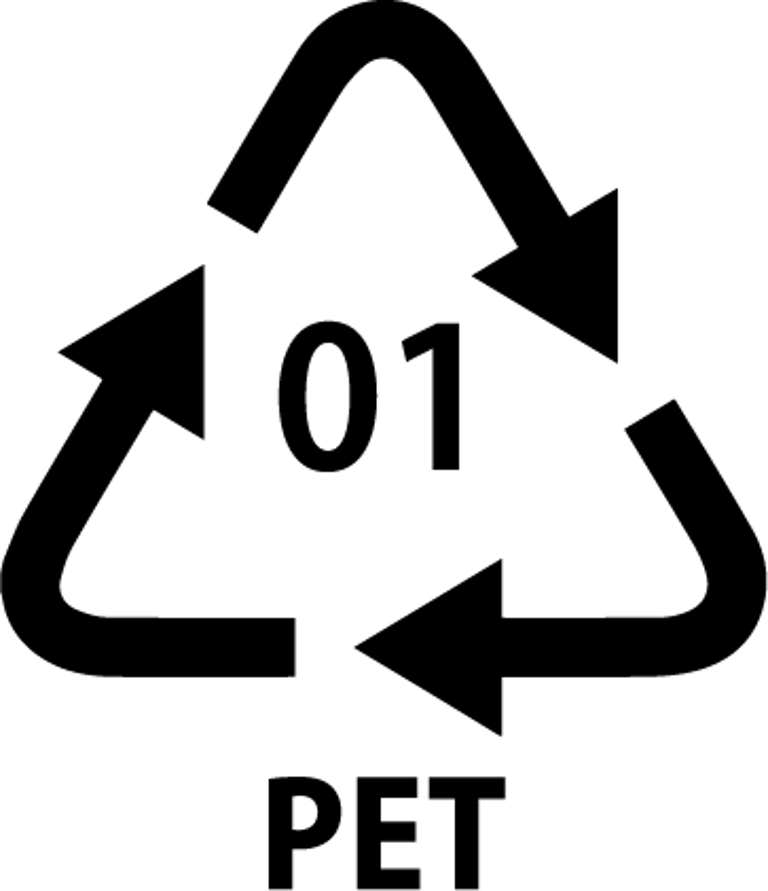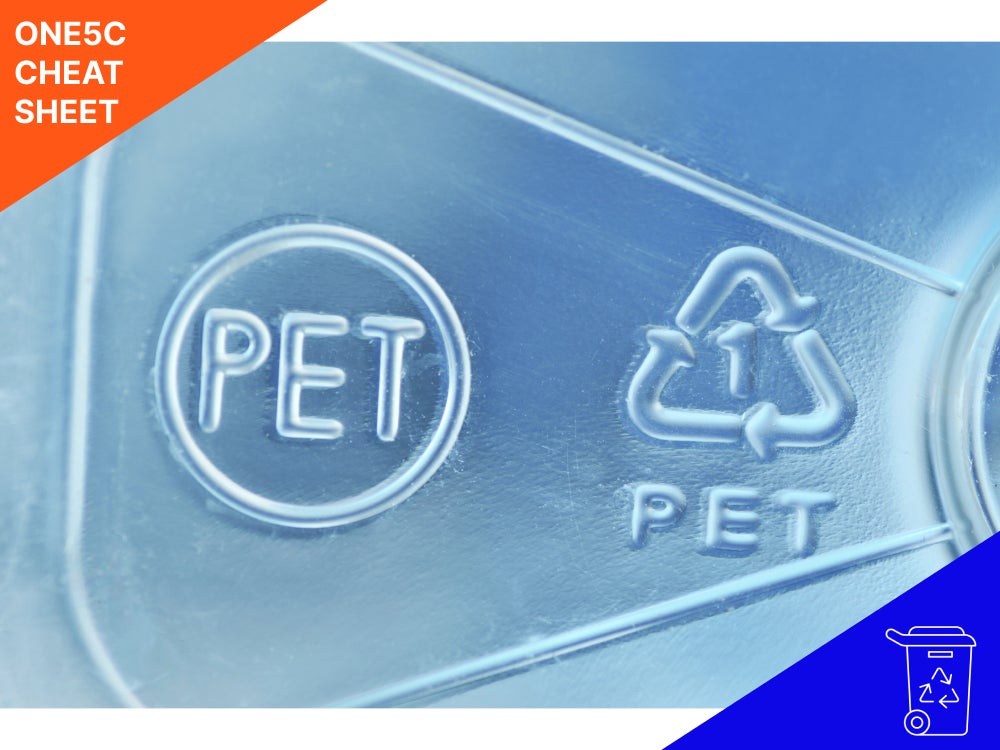You probably see it every day: On nearly every bit of plastic sits a number inside a triangle of three arrows. These plastic recycling numbers and symbols, called resin identification codes, can be used to determine if an item is easily recyclable. But when they were originally created by a group that’s now called the Plastics Industry Association in 1988, they were intended simply to identify the type of material at hand. For that reason, the symbols can be misleading and often lure consumers into believing that merely the presence of the number means that the plastic is recyclable—even though not all of the materials can or will be recycled.
What do recycling numbers mean?
The number stamped on a piece of plastic is determined by what type of plastic the given object is made from. And, yes, it also indicates its recyclability. There are seven numbers, but you can only count on numbers 1 and 2 to get recycled at traditional facilities. The rest, unless the site has a process in place for that specific type of plastic, typically go to a landfill.
Here’s a breakdown of what the common symbols mean:
| Types of Household Plastic | |||||||
 |  |  |  |  |  |  | |
| Plastic type | PET | HDPE | PVC | LDPE | PP | Poly-styrene | The misfits |
| Common products | Bottles, food jars, condiment and dressing bottles | Cleaning supply bottles, milk jugs, Shampoo bottles | Pipes, cables, medical devices, Toys | Shopping bags, bread bags, plastic wrap | Straws, bottle caps, yogurt containers | Packing material, takeout containers, doffee cups | Baby bottles, automotive parts, food containers |
| Accepted at standard facilities | Yes | Yes | Rarely | Rarely | Rarely, but getting more common | No | No |
| Plastic type | Common products | Accepted at standard facilities |
 | Bottles, food jars, condiment and dressing bottles | Yes |
 | Cleaning supply bottles, milk jugs, shampoo bottles | Yes |
 | Pipes, cables, medical devices, toys | Rarely |
 | Shopping bags, bread bags, plastic wrap | Rarely |
 | Straws, bottle caps, yogurt containers | Rarely, but getting more common |
 | Packing material, takeout containers, coffee cups | No |
 | Baby bottles, automotive parts, food containers | No |
#1 or PET
Polyethylene terephthalate (PET) is most commonly used to make single-use water bottles and jars for foods like jam and peanut butter. This plastic is easily recycled via mechanical recycling—essentially grinding the materials down and mushing them back together—in a traditional facility.
While PET bottles can be reused if washed, health authorities advise against reusing this plastic because bacterial growth can occur very quickly, especially if it’s scratched or dented. PET does not generally release chemicals (aka, leach), but some studies have found that it can release the metal antimony, used in its production, when exposed to heat at or above 185 degrees.1 If left in a landfill or disposed of improperly, PET will not decompose, and it may break into smaller microplastics and contaminate waterways or oceans.
#2 or HDPE
High-Density Polyethylene, or HDPE, is commonly found in containers for cleaning supplies and cosmetics, and is easily and commonly recycled. There are little to no risks of leaching of compounds harmful to human health2 with this type of plastic in general, although the FDA only approves recycled version of it for use with food on a case-by-case basis. That’s because the plastic can sometimes hold onto the material that it previously held, so cleaning product containers (no matter how much they’re scrubbed) should never be reused with food. Unlike PET, HDPE can withstand very high temperatures for short periods of time, even above 200 degrees, but like PET it will remain in landfills or contaminate waterways or oceans if improperly disposed of.
#3 or PVC
PVC, or Polyvinyl Chloride, is not easily recycled and is not accepted by most recycling centers. PVC is commonly found in plastic pipes, electronics cables, medical devices, and some toys, and it can withstand temperatures up to 140 degrees. PVC does not easily degrade over long periods of time, and it contains phthalates, which are endocrine disruptors, can leach from some PVC products to a limited extent.3 Better to be safe: You should avoid using PVC around food or drinks.
#4 or LDPE
LDPE stands for Low-Density Polyethylene. Many grocery bags, plastic wraps, and other items wrapped or stored in plastic are made of the stuff—though not all of it will have the #4 label. Most standard recycling centers do not take LDPE, but some grocery stores run programs to collect it for recycling, including Giant, Harris Teeter, Walmart, and Safeway. LDPE is considered safe for reuse, but only for the types of substances it originally held. LDPE can withstand temperatures of at least 140 degrees and sometimes as high as 190. These plastics, when left in a landfill, may produce trace amounts of airborne particles, including benzene and other greenhouse gasses.4
#5 or PP
Polypropylene, or PP, is the substance commonly found in straws, bottle caps, and some flexible food containers like yogurt. This plastic can be safely reused and has no known leaching effects for common endocrine disruptors. While PP has been difficult to recycle historically because it holds onto the smell of the original product it held, new processes that use solvents to dissolve the plastic into its component parts have made it more widely recyclable and addressed the smell issue. More recycling centers take this number now than they have in the past, but recycling rates remain low globally.5 Because products made of PP are typically intended for single use, they end up in landfills at very high rates and eventually break down into microplastics that contaminate waterways.6
#6 or PS
Polystyrene (PS), or styrofoam, can occasionally be recycled but is not accepted by all centers because the high volume of air it contains makes the process inefficient. In addition to the ubiquitous packing peanuts, the foam is also common in insulated takeout containers and cups. Polystyrene can leach styrene and benzene into liquids, especially when heated, and generally has a maximum temperature of 165 degrees before it starts spitting out harmful compounds. Because polystyrene is so bulky, it takes up large percentages of landfill space and is often identified as the most common plastic pollutant found in waterways and oceans.7
#7: The misfits
Number 7 plastics are typically a mix of plastic types and don’t fit into the other six categories. You’ll commonly encounter it in products like baby bottles and car parts. These plastics can be difficult to recycle and may contain unsafe compounds that can leach into food or water. Because the type of plastic tends to be a mystery, it’s not a good idea to reuse or heat these containers. Most of these plastics end up in landfills, and they degrade or decompose at varying rates depending on the specific materials at hand.
How to recycle plastics properly based on their numbers
As you prepare your spent containers to (hopefully) find new life, there are a few things to do to ensure the most amount possible actually gets recycled. There are three things you should always do to maximize recyclability:
- Check with your recycling center about what they accept. Most facilities will take plastics numbered 1 and 2, but beyond that is case-by-case. It’s not a good idea to put absolutely everything in the recycling bin if you’re not sure what the center will take. Commingling numbers decreases the likelihood that your castoffs will be recycled at all.
- Toss unidentified objects. Don’t put plastics without any recycling numbers or symbols—say, an unmarked takeout container—into the recycling stream. While these may technically be recyclable, their presence and lack of clear labeling could spoil the lot.
- Clean up after yourself. For any recycling to work, all plastics should be cleaned thoroughly of any food or other schmutz. The substances inside of or on a plastic can make it unusable for recycling or even ruin an entire batch.
There are seven numbers, but you can only count on numbers 1 and 2 to get recycled at traditional facilities.
What is leaching?
Certain compounds from some plastics can leak from the container into the substance it is holding, like shampoo or soda pop. This process is known as leaching. The most common compounds that could pose health concerns are phthalates and bisphenols—this includes the infamous chemical BPA). These compounds come from the additives that make plastic flexible (think plastic wrap) and those that make it very hard and inflexible (think hard food containers). This is why many reusable plastic water bottles tout “BPA-free” labels. Research—primarily in animals, but some limited studies in humans—indicates that phthalates and bisphenols can act as endocrine disruptors, which can cause or exacerbate a range of health concerns including cancer and reproductive dysfunction.8
Once plastics begin to break down into smaller parts in landfills or in the environment, they can release organic contaminants that are harmful to plant, animal, and human health and create pollution in waterways and on land. This is called environmental leaching, and the contaminants released can include a range of chemicals: immune-disrupting polychlorinated biphenyls (PCBs), hydrocarbons, BPA and other nasties.9
What are bioplastics, and can they be recycled?
Some, but not all, bioplastics, can be recycled. Most plastics are derived from petroleum products, but bioplastics are typically derived from plant-based products like corn. The term “bioplastic,” however, can be ambiguous and is often mis-applied to products that originate from fossil fuels, according to a 2022 review published in the journal Nature.10
Bioplastics are technically biodegradable—meaning they eventually break down into compounds found in nature, like water, nutrients, carbon, and other inorganic materials. But that isn’t necessarily easy or a good thing: Most need to be sent to an industrial composting or degrading facility to be reduced to their component parts. Bioplastics labeled “BioPET” and “BioPe” can be recycled with traditional plastic because they are chemically identical to their petroleum counterparts.11
Other bioplastics should not be recycled in the usual recycling stream because they can contaminate a batch. Some bioplastics are compostable, but that doesn’t mean you can toss them in your backyard heap: Most require more heat to spur for microorganisms to metabolize than a home composting system will produce, according to EPA guidelines.
How are different types of plastics recycled?
While not all plastics can be recycled, there are two main methods used for the plastics that can be broken down and reconstituted.
Mechanical recycling
Most plastics are recycled in a process called mechanical recycling, where all plastics of the same type are broken down and ground down into smaller pieces. They are then compounded together again into either the same product or a lower-quality version of the same product. Plastic numbers 1 and 2 are most commonly recycled this way, as they are the most likely to become a high-quality, usable plastic again.
Mechanical recycling is complicated by plastics that have a mix of plastic types or other materials, making it difficult to break down and create the same material again. This is the case for plastics numbered 3-7.
Chemical recycling
Chemical recycling, a chemical process used to separate and then reconstitute plastic types, has become more practical in the last few years.12 Only experimental quantities of plastic have been recycled this way thus far, but the first chemical recycling plants in the United States are currently under construction. Introducing chemical agents to mixed-waste breaks down the plastics into their building blocks, making them easier to separate and sort before making them back into plastic again. This means that mixed-waste and contaminated plastics can all be recycled together; but, because of the relatively new nature of this technology, this type of recycling is very uncommon.
Other forms of recycling
Not all plastics can be recycled mechanically or chemically, and most plastics intended for recycling actually end up in landfills or even incinerators. Because recycling can be so ineffective, reducing plastic consumption is still the most effective way to prevent plastic from ending up in a landfill or another waste stream.
- Antimony leaching from polyethylene terephthalate (PET) plastic used for bottled drinking water, Water Research, Feb. 2008. ↩︎
- The effect of storage time, temperature and type of packaging on the release of phthalate esters into packed acidic liquids, Food Technology & Biotechnology, Dec. 2017. ↩︎
- Long-term fate of PVC products and their additives in landfills, Progress in Polymer Science, Dec. 2002. ↩︎
- Plastic waste degradation in landfill conditions: The problem with microplastics, and their direct and indirect environmental effects, International Journal of Environmental Research and Public Health, Oct. 2022 ↩︎
- Environmental impacts of polypropylene (PP) production and prospects of its recycling in the GCC region, Materials Today: Proceedings, Dec. 2021. ↩︎
- Quantifying the fragmentation of polypropylene upon exposure to accelerated weathering, Microplastics and Nanoplastics, Sept. 2022 ↩︎
- Breaking down ocean polystyrene, Fauna and Flora International, Jul. 2020. ↩︎
- EDC-2: The Endocrine Society’s second scientific statement on endocrine-disrupting chemicals, Endocrine Reviews, Dec. 2015. ↩︎
- Transport and release of chemicals from plastics to the environment and to wildlife, The Royal Society Philosophical Transactions B, Jul. 2009. ↩︎
- Bioplastics for a circular economy, Nature Reviews Materials, Jan 2022. ↩︎
- Recycling of bioplastic waste: A review, Advanced Industrial and Engineering Polymer Research, Jul. 2021. ↩︎
- Advanced recycling: Opportunities for growth, McKinsey and Company, May 2022. ↩︎

